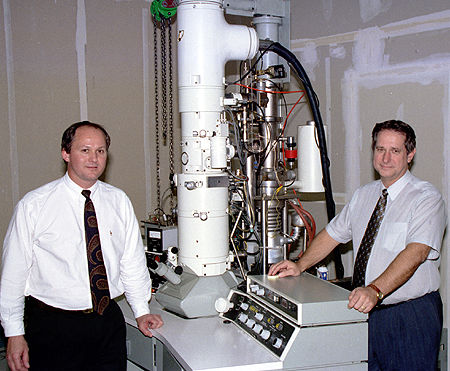Hacienda's JEOL Serves Scientific, Silicon Communities and a Nobel Prize Winner
Hacienda's JEOL Serves Scientific, Silicon Communities and a Nobel Prize Winner

In addition to being giants of commerce in their own right, Hacienda companies collectively have a client list that reads like a who's who of international business. Hacienda's service office for JEOL USA may be unique, however, in the fact that they've worked with a Nobel prize winner and helped put a robot on Mars.
JEOL USA is one of the world's largest manufacturers of scientific instruments such as scanning and transmission electron microscopes and electron beam lithography systems. A staff of 15 service technicians work out of the Hacienda office, which is also home to the second largest JEOL parts depot in the country.
Dr. Stanley B. Prusiner, a UCSF researcher whose microscope is serviced from the Hacienda office, discovered prions, which won him the 1997 Nobel Prize in Medicine. (Prions, pronounced "pree-ons," are an infectious agent suspected to play a part in many neural conditions, including Mad Cow Disease.) A piece of JEOL equipment created some application-specific integrated circuits (ASICs) that were used in the Mars lander that sent such stunning pictures back to Earth.
While not all their customers are that well known, JEOL's electron microscopes are used by scientists and researchers in an enormous variety of fields.
"One time I went down to the Arkansas Crime Lab to work on a scanning electron microscope (SEM)," recalls Jack Waggoner, JEOL regional manager. "They had found a skeleton with a nick in one of the ribs. They put a sample from that nick into the instrument and were able to identify lead, which meant he had been shot."
"You can look at a bad silicon wafer and see the exact problem," adds Todd Carey, district manager. "If there are any contaminants, you can see them."
Repairing the equipment can be complicated, as you might expect from devices that make visible individual gates on silicon chips or the actual atomic structure of materials. Both Waggoner and Carey give the impression, though, that they've long since memorized the parts diagrams and mechanical operations of the entire JEOL product line.
It's something that everyone who works in JEOL's service branch, even the executives, should be able to do.
"Our vice president in charge of service and the national service manager, both of whom sit on our board of directors, started out as a field service engineers, just like all of us did," notes Waggoner.
Despite the importance of their work, it's a job that has a lighter side, too.
"It's difficult when people ask me what I do for work," says Todd Carey, district manager of JEOL USA. "You have to go into a 15-minute spiel about what an electron microscope is..."
"...or you just give them the short version, which is 'I work for a scientific equipment manufacturer,'" adds Jack Waggoner, JEOL's regional manager.
If they ever award a Nobel for service, look for JEOL at the ceremony. They've earned it.
Photo: JEOL district manager Todd Carey (left) and regional manager Jack Waggoner stand next to an older electron microscope, in the shop to be refurbished.
Also in this issue...
- Randstad Communications Brings Headquarters to Park
- Network Robots Offers Internet Breakthrough
- Business Bits
- Executive Profile: John Salle, 1st United Services Credit Union
- Hacienda's JEOL Serves Scientific, Silicon Communities and a Nobel Prize Winner
- Hacienda's Real Estate Professionals, Combined with City Programs, Offer Great Housing Resources for Buyers, Renters
- Hacienda Companies Honored by Mayor for Continued Use of Commute Alternatives
- @Work Financial Workshop Offered at Discount to Hacienda Employees
- Wine, Food are the Stars at 17th Annual "Taste of the Valley"
- Hacienda Index




